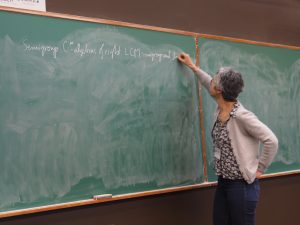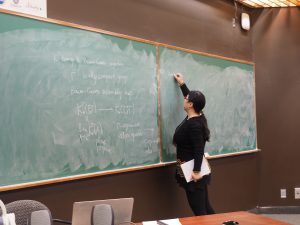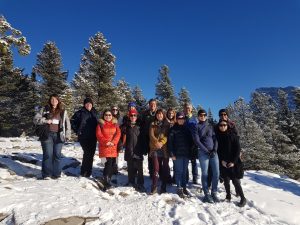
BIRS Women in Operator Algebras (WOA) Workshop
by Dawn Archey
In November 2018, 36 women in operator algebras met at the Banff International Research Station (BIRS) to collaborate in small groups on open research problems in the field. The workshop was a success by any metric: research questions were refined, theorems were proved, and professional networks were extended and strengthened.
Operator algebras is a very active branch of functional analysis. Its rich yet rigid structure admits a powerful general theory. Operator algebras have important applications to quantum mechanics, number theory, dynamical systems, and ergodic theory. Unfortunately, even compared to other areas of mathematics, operator algebras has suffered from a severe gender imbalance. Only 11% of authors posting in the operator algebras subject of the ArXiv are women, the second lowest of any mathematical subject on the ArXiv [1].
In light of these low participation numbers and inspired by previous “Women in …” workshops such as Women in Number Theory, Astrid an Huef (Victoria University of Wellington), Sarah Arklint (University of Copenhagen), Karen Strung (Radboud University), and Dilian Yang (University of Windsor) applied to hold the first Women in Operator Algebras Workshop at the Banff International Research Station (BIRS). The application was successful, and BIRS provided all accommodation and meals, and very good working facilities. We also received some funding towards the cost of travel for some participants from the NSF-HRD 1500481 — AWM ADVANCE grant and from the Compositio Foundation. We are very grateful for all the support we have received.
Prior to the workshop, the women organized themselves into teams focusing on a research question to which they could contribute. The research groups were:
- “Quantum majorization in infinite-dimensional Hilbert Space” lead by Sarah Plosker with participation by Sasmita Patnaik, Emily Redelmeier, and Priyanga Ganesan.
- “Nuclearity of C*-algebras of quasi-lattice ordered groups” lead by Astrid an Huef with participation by Brita Nucinkis, Camila F. Sehnem, and Dilian Yang.
- “Equilibrium states on semigroup C*-algebras and groupoids” lead by Nadia Larsen and Zahra Afsar with participation by Anna Duwenig, Carla Farsi, and Judy Packer,

Dr. Nadia Larsen speaking on semigroup C*-algebras
- “Weyl groupoids and Cartan subalgebras for twisted k-graph C*-algebras” lead by Elizabeth Gillaspy and Sarah Reznikoff with participation by Rachael Norton and Sarah Wright.
- “Twisted groupoid algebras and Cartan subalgebras” lead by Lisa Orloff Clark with participation by Becky Armstrong, Kristin Courtney, Ying-Fen Lin, Jacqui Ramagge, and Kathryn McCormick.
- “Generalized crossed products and large subalgebras” lead by Dawn Archey and Karen Strung with participation by Maria Stella Adamo, Magdalena Georgescu, Ja A Jeong, and Maria Grazia Viola.

Dr. Wang explaining the project she will lead
- “Index theory and K-theory with applications to arithmetic groups” lead by Maria Paula Gomez Aparicio and Hang Wang with participation by Sara Azzali, Sarah Browne, Maria Paula Gomez Aparicio, and Lauren Ruth.
- “Quantum principal bundles and their C*-algebras” lead by Francesca Arici and Chiara Pagani with participation by Erin Griesenauer.
Most of the workshop was spent working in these small groups, but on Monday and Friday each small group gave a 10 minute presentation to all participants on their project and progress.

Happy hikers at the top
Participants also took advantage of the location for a group hike up Tunnel Mountain and a visit to a current art installation by Young Joon Kwak at the Banff Center called “The Cave” which works with the themes of the man cave, the body, heteronormative culture, and national parks. One evening was devoted to a group discussion facilitated by Carla Farsi (University of Colorado (Boulder)), Ying-Fen Lin (Queen’s University Belfast), and Jacqui Ramagge (University of Sydney) on the issues faced by women in mathematics in general and in operator algebras in particular.
Several of the groups were so pleased with their progress and prospects for future success that they have already made arrangements to meet again.
This article originally appeared on page 20-21 of the January-February 2019 issue of the newsletter of the Association for Women in Mathematics.
References
- Brisbin, A. and Whitcher, U. (2017) “Women’s Representation in Mathematics Subfields: Evidence from the ArXiv”, Accessed from URL https://arxiv.org/abs/1509.07824

Leave a Reply
You must be logged in to post a comment.